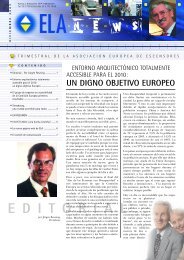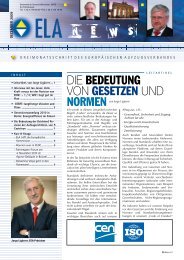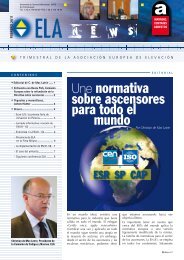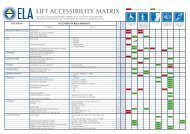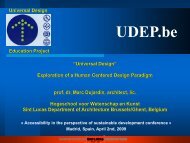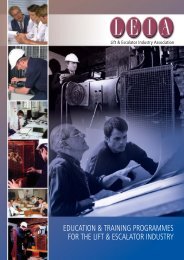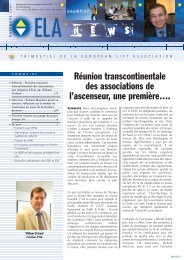WP6-Brochure-E4 brochure - ELA European Lift Association.
WP6-Brochure-E4 brochure - ELA European Lift Association.
WP6-Brochure-E4 brochure - ELA European Lift Association.
You also want an ePaper? Increase the reach of your titles
YUMPU automatically turns print PDFs into web optimized ePapers that Google loves.
This indicates that expertise is limited, due to the complexity of the products, the low degree<br />
of comparability between installations and due to missing data and standards for measuring<br />
energy consumption, as well as rapid technological advances in some areas. However, no clear<br />
advice could be derived regarding measures to overcome the problem of missing data. On the<br />
one hand, doubts were repeatedly expressed about the possibility of giving standardised<br />
advice on how to achieve energy efficiency and economic efficiency for an individual<br />
installation. On the other hand, it is claimed that exactly this kind of information is needed.<br />
Additionally, some interview partners emphasised the importance of drawing more attention<br />
to balancing financial investments and possible savings.<br />
Regarding retrofits, doubts were expressed whether it makes sense to modernise an<br />
installation only to enhance energy efficiency. In general, some experts pointed to the long<br />
life‐cycles of installations which offer a long time range for investments to become efficient.<br />
Moreover, economic efficiency was perceived to be more easily realised for large‐scale<br />
installations than for small‐scale ones.<br />
We further asked experts to elaborate on the decisive aspects for customers when choosing an<br />
installation. Price was pointed out by the majority as the central aspect. The amount of<br />
investment is especially influential for the buying decision if the customer is not the final<br />
owner and/or user of the installation, i.e. if a building is erected by a general contractor. Lifecycle<br />
costs – and therefore costs for energy consumption – were hardly mentioned as a<br />
decisive criterion.<br />
Further aspects seen as influential in the choice of a model were maintenance, services offered<br />
by the manufacturing company and – to a lesser degree – running speed, comfort, interior and<br />
aesthetics as well as running smoothness. Moreover, the interview partners acknowledged<br />
that the intended usage, e.g. capacity, aspects related to accessibility, also influences the<br />
choice of equipment. However, several experts complained that the requirements of<br />
equipment are often not thoroughly analysed, thus leading to misspecifications. From an<br />
architectural point of view, the amount of space needed for the lift shaft was also seen as an<br />
important aspect. Surprisingly, safety was only mentioned twice; however, we assume that<br />
this is due to high safety standards already implemented.<br />
We also asked if existing legislation, regulations or norms impede energy efficiency, thereby<br />
creating a barrier. However, most respondents confirmed that this is not the case. On the<br />
contrary, experts pointed out that lifts and escalators suffer from a lack of regulation, e.g. as<br />
they are not included in the EPBD and their national implementations. Legal uncertainty was<br />
repeatedly discussed in connection with regeneration – an issue that will be further discussed<br />
below.<br />
Regarding differences between lifts and escalators, the statements of the experts confirm our<br />
analysis. As lifts are more complex, they yield more potential for improvement in terms of<br />
energy efficiency. Moreover, escalator models from different manufacturers are<br />
technologically similar, i.e. competition in the market is mainly about prices.<br />
94





